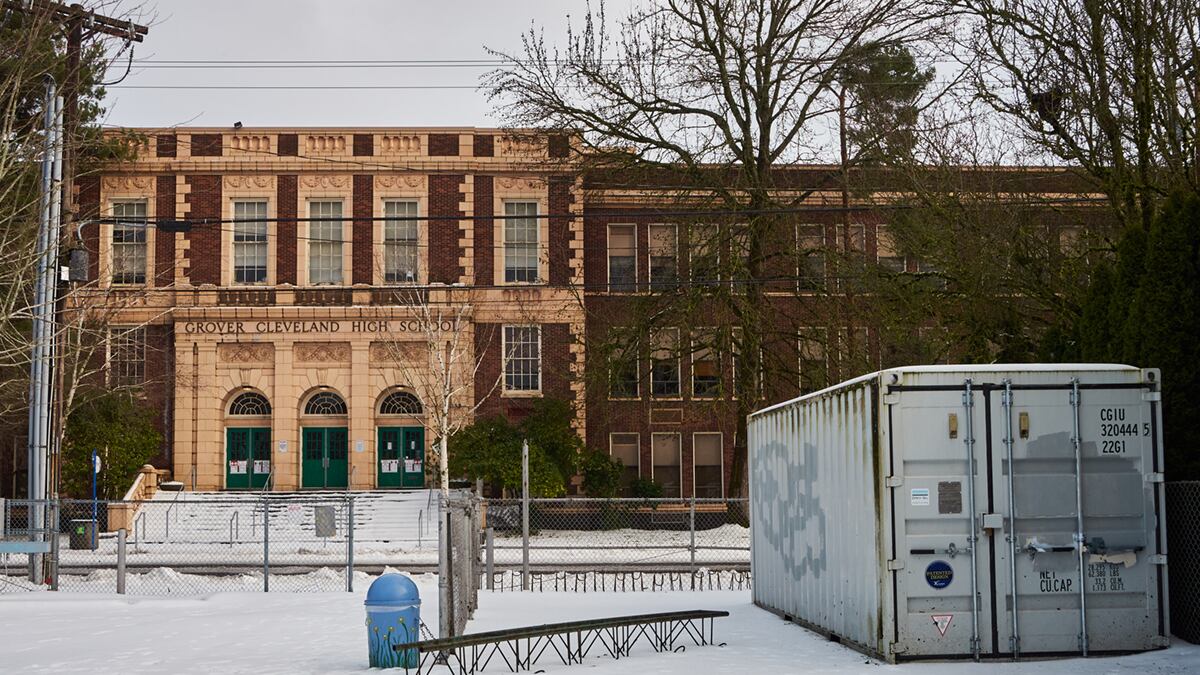Portland Public Schools hopes to reopen in April but more than 40 percent of its 94 school buildings are 90 years old—and many have questions surrounding their ventilation.
Clean air is a key way to prevent COVID-19 from spreading. Just as the coronavirus is less likely to spread outdoors, it's less likely to spread when fresh air is regularly brought inside and old air is blown out.
There is reason to think PPS buildings will have problems doing that.
An analysis conducted last year to assess needs for the latest PPS school bond found a significant challenge for a district looking to reopen at least its elementary schools in early April after a yearlong closure.
The 2020 analysis found $203 million in needed HVAC repairs, of which $34 million worth were considered a matter of "health and life safety." At 26 buildings with health and life safety problems, boilers, piping, ductwork or other parts of the HVAC systems had exceeded their natural life span.
Those buildings included Bridlemile and King elementary schools, as well as Cleveland High School.
That PPS has aging buildings is not a startling revelation—not to the district, which a decade ago embarked on a 30-year plan to overhaul its buildings, or even to taxpayers, who have so far agreed to finance three major school bonds totaling $2.5 billion.
The health risks of old buildings aren't a revelation either. The district's superintendent resigned five years ago after WW revealed elevated lead levels had been discovered in water coming from the district's drinking fountains and faucets.
But in the middle of the pandemic, the old buildings present a new risk. For students and teachers to return safely, PPS will need to ensure that ventilation systems are in working order.
A district official did not answer repeated inquiries from WW about how much of the work identified in the 2020 analysis had been completed.
Instead, the district cited its work specific to the pandemic in getting existing HVAC systems running, including hiring a "certified industrial hygienist to create a building ventilation plan specific to PPS that complies with the guidance of these public health agencies"—specifically, the U.S. Centers for Disease Control and Prevention, the Environmental Protection Agency, and Oregon Occupational Safety and Health.
"We have met all guidance for reopening schools and are prepared to do so safely," says PPS spokeswoman Karen Werstein.
But the district declined to provide WW with results of any recent air quality testing. "Air quality testing is not part of the [CDC] guidance," says Werstein. "We do air quality testing as part of our normal practice, but I do not have the results of each test we do as part of our normal practice to share at this moment."
"The academic, social, and emotional damage to our kids during this pandemic is unprecedented," says PPS board member Andrew Scott. "The CDC says it is safe to reopen schools, so we need to quickly address the concerns of our teachers, staff, and students so that everyone feels safe returning to the classroom."
But state and national support for fixing buildings has been absent for generations, local leaders say.
"Just as the COVID pandemic has revealed all the many ways this country is broken, this is yet one more—that we have fundamentally failed to safeguard national infrastructure, schools being one of them," says PPS Board member Rita Moore. "I think PPS is doing everything humanly possible to mitigate the reality of old buildings."

Whether the district can provide sufficient ventilation in schools appears central to the question of whether they can reopen safely—a matter of concern shared by teachers, parents and students whose interests have at times diverged as school reopenings begin.
Some parents have been clamoring for schools to reopen even before Gov. Kate Brown gave teachers priority to get vaccinated, and teachers have still not reached an agreement with the district over their return to school. (Disclosure: This reporter is the parent of a PPS elementary school student.)
Fixes to a ventilation system are perhaps the most expensive element of plans to reopen.
And part of the difficulty for PPS and other districts is that state and federal governments have not set a specific air quality standard for reopening buildings during the pandemic.
When Gov. Brown renewed her push last month for elementary schools to reopen by Feb. 15, the Oregon Department of Education said Jan. 19 the agency was providing "updated advisory metrics aligned to the Harvard Global Health Institute recommendations."
Harvard Global Health Institute has seven recommendations for infection control, including mask wearing and social distancing but also "achieving four to six air changes per hour of 'clean' air through any combination of ventilation and filtration (or outdoor classrooms)"—meaning air in the room is replenished four to six times each hour by air from the ventilation system or a window.
But ODE acknowledged to WW last week that its guidance to schools did not include that piece of the Harvard recommendations—and, in fact, includes no recommended number of air changes.
Nor does the CDC guidance on school reopening issued Friday by the Biden administration.
"Why the hell did the CDC not weigh on ventilation, given everything we know about this disease?" Moore says. "What the fuck is that? I think this a complete abdication of the CDC's responsibility. And it's requiring individual school districts that are not public health entities to make their own plans regarding public health. I mean, what the fuck?"
Without specific state or federal guidelines, Portland Public Schools is left to negotiate the matter with its teachers' union. In other districts across the country, negotiations with unions have delayed or blocked school reopenings. And the Portland Association of Teachers has asked the district for a ventilation standard higher than Harvard's—nine air changes an hour—as well as evidence of air quality standards being met.
"Adequate ventilation in any space that would be used for instruction or for people to meet is crucial and cannot go on guesswork or assumptions," says PAT president Elizabeth Thiel.
The school district has not agreed to those demands. And it hasn't shown the union the results of its air quality tests, either.
"That's probably been one of the biggest sticking points—adequate ventilation," says Thiel. "Portland public schools are very old. Sometimes we've been told that mitigating the airflow is too expensive to ask for, but if it's the most important thing in not spreading COVID, we've got to address it in order to make our environment safe."
To be sure, other school districts face the same problem. As the Washington Post reported Feb. 16, 40% of school districts "need to update or replace HVAC systems in at least half of their school buildings, affecting 36,000 school buildings nationwide," according to a June 2020 Government Accountability Office report.
The preponderance of scientific evidence suggests schools can be reopened without further spreading the virus in the community. And keeping schools shuttered comes with clear costs to children, not all of whom can get online or stay engaged with online-only instruction.
Children have so far shown less risk of getting the disease or its serious complications and less risk of spreading it. And there is a documented cost for children being out of school.
"The teachers seem to be irrationally afraid of COVID, and they seem immune to [the fact] that we have a great deal of data at this point about how safe it is," says Kim McGair, a PPS mother who helped launch ED300, a group lobbying for faster school reopenings. "The American Academy of Pediatrics has been out front on this issue. They are the ones that see kids and know kids, and they are [saying] get kids in school."
At the same time, it's not clear that PPS's plans for reopening will be successful. A new and more contagious variant of the coronavirus has arrived in Oregon. And countries that have kept their schools open and their case counts down have responded to the new variant by closing schools again.
PPS is trying to reassure parents and teachers that it has done enough to circulate healthy air through its classrooms.
According to a document provided to WW, the outside consultant hired by the district looked at whether each HVAC system was operating; the "area around the HVAC system was clear of potential contaminants"; the filters fit and were clean; and the air intake for the system was functioning.
Not all of the fixes have been made, but the district says they will be by the time schools reopen. And the district says every school has a functioning damper—the intake where the school's ventilation system admits air from outside. The district also plans to run its ventilation systems about four hours longer per day, for two hours before and after the buildings open and close.
The district hasn't said how much it's spending, or how much of the $203 million in ventilation upgrades still need to be addressed. But PPS officials are all too aware that air quality is not the only health and safety risk the district's aging buildings face—or the most expensive.
Portland Publics Schools estimates it has a billion dollars in seismic upgrades to bring its buildings up to safety standards for life in an earthquake zone.
"We have old buildings. Our buildings need a lot of work," says Werstein. "We are constantly doing HVAC and other repairs, and so are very appreciative of the voters supporting the bonds so we can continue to do these kinds of repairs."

